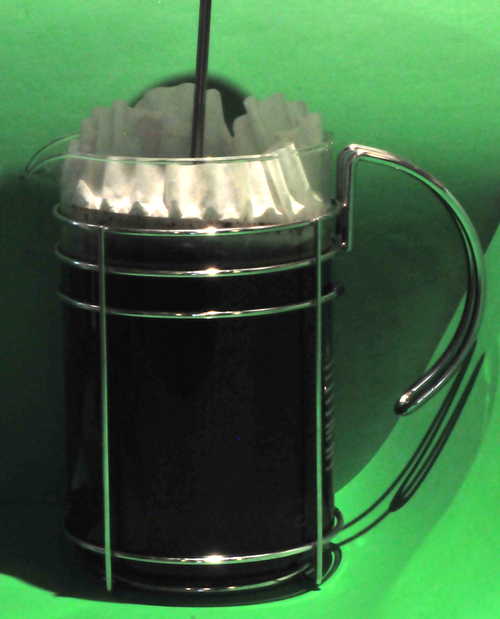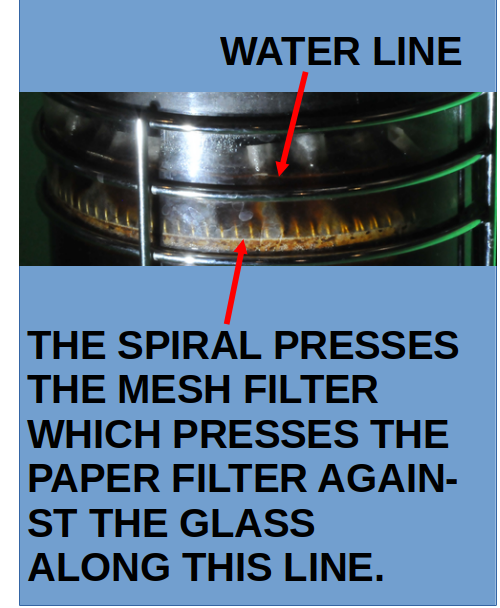Description
I got a 1.5 liter French Press because I drink around a liter (or a quart) of coffee per day and I only want to make coffee once per day. The result was something like the time I thought it would be a good idea to drink a mug of espresso. My digestive system was very unhappy.The solution is to perch a paper basket filter on top of the French Press and then insert the plunger. The result is delicious coffee that doesn't upset my tummy.
I measured the resulting brew with a toy laser and a Raspberry Pi HQ camera.
Details
INTRODUCTION
I got a 1.5 liter French Press because I drink around a liter (or a quart) of coffee per day and I only want to make coffee once per day. The result was something like the time I thought it would be a good idea to drink a mug of espresso. My digestive system was very unhappy.For the next batch I set a Bunn basket with a paper filter on top of a coffee pot and ran the French Press coffee through that. My tummy was happier but it took a long time to run the coffee through the filter and I had to do some juggling because the filter clogged and I had to change it.
The AeroPress, whose coffee I love, has a rather small filter which doesn't clog because the coffee is forced through it. I had previously spent some time thinking about that and came up with the idea of a paper filter on a French Press plunger. It's not an original idea. example_1 example_2
Both of the above examples involve taking the plunger apart and sandwiching in a piece of filter paper. That has two problems: it's more work, and the gap between the plunger and the beaker isn't well sealed. I haven't tried the experiment but it seems that would be the route the coffee would take. That said, both the linked examples above report that the coffee is much improved.
The solution is to perch a paper basket filter on top of the French Press and run the plunger down through that. The spiral and mesh filter press the paper filter against the glass and create quite a good seal. The result is delicious coffee that doesn't upset my tummy.
THE PROCESS
The coffee is ready to plunge.
Perch a paper basket filter on top of the beaker.

Insert the plunger.

Start to plunge.

I shine a flashlight on the plunger to watch for leakage past the line where the spiral and mesh press the paper against the glass. Yes, the paper is really there but has become translucent.
There are some signs of leakage: the bubbles below the seal will move, the waterline will bulge slightly above a leak, any visible particles may move, and something that looks like a dust storm will appear above the leak. Usually, stopping the press for a few seconds fixes the leak.
The press takes about a minute.
THE FRENCH PRESS TECHNIQUE
I use James Hoffmann's technique. I give it an extra stir right after the water has been added to break up any clumps that might prevent the water getting at all the coffee. For the stir before skimming, I back stir a bit to stop the fluid from rotating. Otherwise, the coffee grounds seem to pile up one one side.MEASURING THE RESULTS
I use this technique. It gives an indication of colloids, and larger particles.
The shape of the curve depends on the likelihood of collisions between particles and photons. In this case, we see a big difference between the unfiltered coffee and the filtered versions. There wasn't much difference between the filtered versions. (The external filter is where I placed a Bunn basket with a paper filter over a coffee pot and poured the French Press through it.)
WHERE WE'RE AT
The James Hoffmann technique takes 10 - 15 minutes. This filter technique may add a half a minute to that. In that light, it's a small investment for a big effect. ie. I get delicious coffee that doesn't cause distress to my digestive system.The technique might be improved using an o-ring to improve the seal. It's also possible to fabricate a silicon seal. food safe example The next time I'm at the jobber's to buy drill bits etc. I'll try to remember to ask if they have the right size o-ring.
I left a sample in the graduated cylinder over night to see if there would be sediment. There didn't seem to be, but there was a bit that floated to the surface. That will probably bug me enough that I'll eventually try an o-ring.